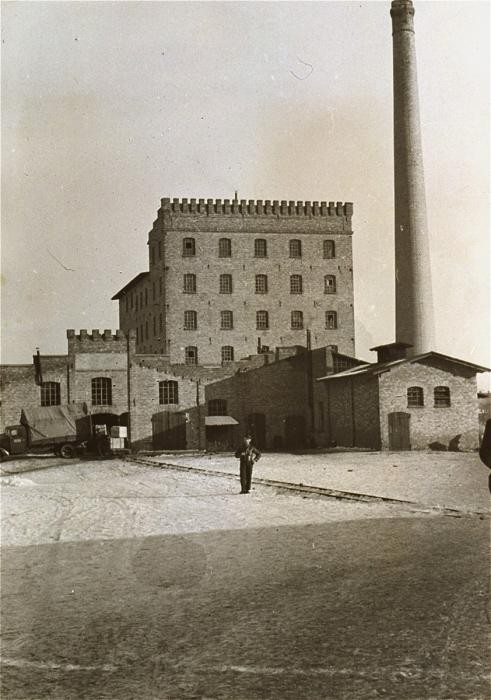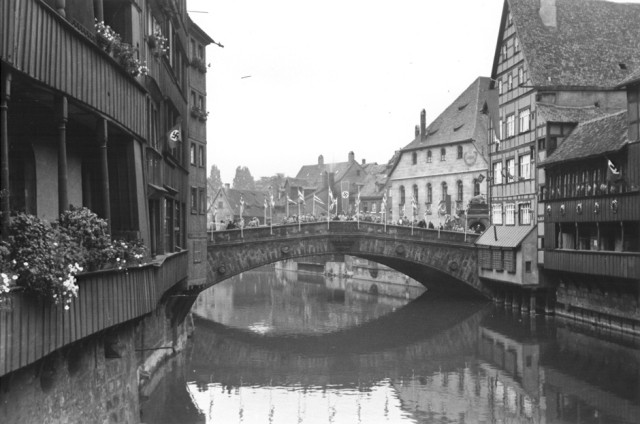Displaying: 451 – 475 of 1,022 matches for “Holocaust Encyclopedia: Warsaw”
-
451. Edwarda Kleinfeld Rorat describes emotions upon liberation
Warsaw and moved to a small village near Lublin. Her parents were murdered by German soldiers in 1942
-
452. Helen Dreksler Zimm describes obtaining a false birth certificate
Lodz to a town between Lodz and Warsaw. After two years, in 1942, Helen
-
453. Prewar portrait of Pinchas and Roza Zygielbojm
Prewar portrait of Pinchas and Roza Zygielbojm taken in 1936 in Warsaw, Poland. In 1942, they
-
454. Deportations from Lodz to Chelmno
Warsaw.
-
455. View of the refugee camp in Zbaszyn

. Warsaw-based historian, political activist, and social welfare worker Emanuel Ringelblum spent five weeks
-
456. Doris Greenberg describes arrival procedures at Ravensbrück
Warsaw in 1940. After her parents were deported, Doris hid with her sister and other relatives. Doris
-
457. Abraham Lewent describes deportation to and conditions in Majdanek
Like other Jews, the Lewents were confined to the Warsaw ghetto
-
458. Abraham Lewent describes his father's death at Majdanek
Like other Jews, the Lewents were confined to the Warsaw ghetto
-
459. Doris Greenberg describes conditions in Ravensbrück
Warsaw in 1940. After her parents were deported, Doris hid with her sister and other relatives. Doris
-
460. Emanuel Tanay describes the establishment of the Miechow ghetto
the smuggling of goods to Krakow and Warsaw. He fled to Hungary in the
-
461. Ghettos in occupied Poland, 1939-1941
population as a whole and from neighboring Jewish communities. The Warsaw ghetto, established on October 12
-
462. Ruth Berkowicz Segal describes receiving visa to leave Lithuania
Lithuania. Ruth left Warsaw with two friends to find her father and later ... soldiers from the front. Her mother, brother, and sisters perished in the Holocaust.
-
463. Ludmilla Page describes German industrialist Oskar Schindler
ghetto; her mother was sent to the Warsaw ghetto. Ludmilla worked in a
-
464. Portrait of three-year-old Estera Horn
). She was placed in Warsaw, and eventually transferred to an orphanage in Krakow.
-
465. SS personnel lead Polish women into a forest for execution
Polish women from the Pawiak and Mokotow prisons in nearby Warsaw
-
466. Julien Bryan: Photographs and Film

in Warsaw following the German invasion of Poland. Explore some of his film and photographs.
-
467. Lucine Horn describes the German occupation of Lublin
liquidated the ghetto. She eventually made her way to Warsaw where she first
-
468. Ludmilla Page describes arrival at the Brünnlitz munitions factory
ghetto; her mother was sent to the Warsaw ghetto. Ludmilla worked in a
-
469. Lucine Horn describes conditions in the Lublin ghetto
liquidated the ghetto. She eventually made her way to Warsaw where she first
-
470. Isachar Herszenhorn (Irving Horn)
Warsaw. The city was the center of Poland's leather-tanning industry. Isachar's father worked as a
-
471. Rev. Marian Jacek Dabrowski
Marian in Warsaw. He was told that there was no real reason for his arrest, but that as an educated Pole
-
472. Leah Hammerstein Silverstein describes the Tarnow ghetto after a roundup
Leah grew up in Praga, a suburb of Warsaw, Poland. She was active in the Ha-Shomer ha-Tsa ... forced to live in the Warsaw ghetto, which the Germans sealed off in ... also posed as a non-Jewish Pole in Czestochowa and Warsaw, and was a courier for the Jewish National ... (People's Army) during the Warsaw Polish uprising in 1944. Leah was
-
473. Leah Hammerstein Silverstein describes working under a false non-Jewish identity in a German hospital in Krakow
Leah grew up in Praga, a suburb of Warsaw, Poland. She was active in the Ha-Shomer ha-Tsa ... forced to live in the Warsaw ghetto, which the Germans sealed off in ... also posed as a non-Jewish Pole in Czestochowa and Warsaw, and was a courier for the Jewish National ... (People's Army) during the Warsaw Polish uprising in 1944. Leah was
-
474. Felix Horn describes escaping from the Majdan Tatarski ghetto and seeking shelter
escaped and hid, eventually fleeing to the Warsaw ghetto, where Felix and ... Lucine were married. They escaped to the "Aryan" side of Warsaw and obtained false papers. Felix worked ... for the underground during the Warsaw Polish uprising in 1944. He and
-
475. Felix Horn describes attempt to flee from the Majdan Tatarski ghetto
escaped and hid, eventually fleeing to the Warsaw ghetto, where Felix and ... Lucine were married. They escaped to the "Aryan" side of Warsaw and obtained false papers. Felix worked ... for the underground during the Warsaw Polish uprising in 1944. He and
